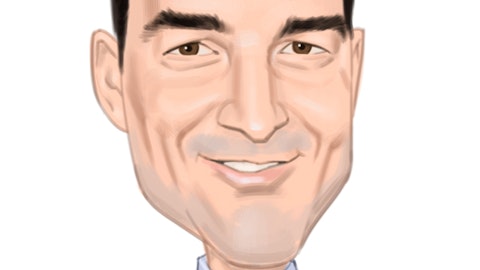Membership Collective Group Inc. (NYSE:MCG) Q4 2022 Earnings Call Transcript March 8, 2023
Operator: Thank you for standing by. At this time, I would like to welcome everyone to the Membership Collective Group Inc. Fourth Quarter 2022 Results Call. All lines have been placed on mute to prevent any background noise. After the speakers’ remarks, there will be a question-and answer-session. Thank you. Thomas Allen, Chief Financial Officer, you may begin your conference.
Thomas Allen: Thank you for joining us today to discuss the Membership Collective Group’s fourth quarter and full year 2022 financial results. My name is Thomas Allen and I’m the Chief Financial Officer. I’m here this morning with Andrew Carnie, our CEO. Today’s discussion contains forward-looking statements that represent our beliefs or expectations about future events. All forward-looking statements involve risks and uncertainties that could cause actual results to differ materially from the forward-looking statements. Some of the factors that may cause such differences are described in our SEC filings. Any forward-looking statements represent our views only as of today and we assume no obligation to update any forward-looking statements if our views change.
By now you should have access to our Q4 and full year 2022 earnings release which can be found at membershipcollectivegroup.com in the News & Events section. Additionally, we have posted our Q4 and full year 2022 earnings presentation, which can also be found in the News & Events section on our site. During the call, we also refer to certain non-GAAP financial measures. These non-GAAP measures should be considered in addition to, and not as a substitute for, or in isolation from, our GAAP results. Reconciliations to the most comparable GAAP measures are available in today’s earnings press release. Now, let me hand it over to Andrew.
Andrew Carnie: Thanks Thomas, and good morning, everyone. I’m going to start by talking through the Q4 and the full year 2022 highlights, then give you an update on progress we’ve made against our two strategic priorities. I’ll then hand over to Thomas to talk through the financial performance and to outline our guidance for 2023 and will end with Q&A. Let’s start with the fourth quarter. We delivered a strong performance due to executing against our strategic priorities, leading to continued revenue and membership growth and improved profitability. Soho House membership hit a new high of 162,000 members a year-on-year increase of 32% and a 6% rise quarter-on-quarter. We came in within our original guidance range despite the decision we made in the third quarter to reduce our annual target for 2022 new Houses openings from nine to seven.
We delivered strong profit growth over the period with adjusted EBITDA reaching $23 million, up $21 million year-on-year and above our implied guidance range of $17 million to $22 million. This was driven by revenue growth, which was up 4% to 7% year-over-year, and the implementation of the Operational Excellence initiatives we outlined last quarter. More on that shortly. While our Q4 results show the progress we’ve made on profitability alongside continued strong membership demand, it’s important to look at our full year 2022 picture to appreciate how much the business has grown year-over-year. The number of Soho House members rose 39,000 or nearly a third. We added around 10,000 members or more in each of North America, the UK and Europe, while our Cities Without Houses program grew the fastest around 45%, highlighting the excitement people have for our membership, even in the cities where we don’t have houses.
Our total MCG membership was up 46% to 227,000 as we also saw strong membership growth in Soho Friends and Soho Works. It was a record year for new applications that are growing in all regions and the MCG wait list rose to 86,000, up 22% compared to 71,000 at the end of 2021, and that’s despite our record intakes throughout the year. The number of Frozen members continue to fall, down approximately 4,500 at the end of 2021 to approximately 2,250 by the close of 2022. We delivered seven new Houses over the year, growing our House footprint by 21% with exciting new USA locations in Nashville, LA and Miami, continued expansion in the UK with Balham and Brighton and our first Scandinavian Houses in Copenhagen and Stockholm. We also expanded outside of our core Soho House business with the net openings in New York and Doha and the opening of The LINE San Francisco.
The growth we’ve seen in membership in new openings as well as strong pricing power drove total revenues up 73% to $972 million. Finally on adjusted EBITDA, we’ve moved from a $24 million loss in 2021 to a $61 million of EBITDA in 2022. While we are proud of the turnaround, it is still early days in our focus of driving improved profitability and 2022 adjusted EBITDA does not reflect the true potential of the business. Finally, it’s worth highlighting that in the fourth quarter we completed our $50 million share buyback program, spending $50 million to purchase 3.5 million shares at an average of $4.31. In total over the year, we bought back 8.5 million shares or 4% of our shares outstanding at an average price of $5.91. Now let me give you an update on the progress we are making against our strategic priorities.
To recap, you’ll remember last quarter that we said we’re refining our strategy to focus obsessively on two things. First, growing enhancing the value of membership to drive long-term recurring revenue, recognizing that membership remains a core driver of our business and second, delivering Operational Excellence to drive profitability and free cash flow, an area where we know we can do more and where we’ve identified and already implemented a number of initiatives. In line with our first priority, today we’ve announced a decision to change the Group’s name from Membership Collective Group to Soho House & Co. As we’ve spent time as a listed company, we’ve recognized the benefits of being associated with a powerful and unique brand. The Soho House name is a huge asset for us and we want to leverage that fully.
This change is also aligned with our move to strengthen our focus on the Soho house business while continuing support our other strong businesses. We would expect the name change to take effect later this month and the stock will trade on the New York Socket Exchange under the ticket SHCO. Members are the heart and soul of Soho House and we know that bringing people together in our houses with great atmospheres is what balances most to them and us. Starting in the fourth quarter and continuing over the recent months, we’ve focused on how we can drive even greater value for our members. We’ve significantly increased the amount of data that we look at by house, which has enabled us to provide the right service at the right time and tailor our programs such as menus and events to the local market and members.
Here are a couple of examples. At 180 House in London, we’ve introduced a more elevated 1970s inspired menu, which leans into design and feel of that house. We’ve also launched new events programming such as weekly jazz nights and daily wellness talks to align with the atmosphere and approach. At two of our houses in Soho, the original, Soho House at 40 Greek Street and 16th Street, we’ve designed new menus to reflect the differing member demographic behaviors and needs of each house. Across all three houses a third of the menu now is bespoke to that club. More broadly, we’ve focused on two main improvements across our houses, driven by member feedback. Firstly, we’ve changed our menus to be more seasonal with more healthy options. Secondly, to improve service across all our houses, we’ve rolled out new staff training and realigned manager incentives with member satisfaction as the primary focus.
Both of these quality improvement processes will continue throughout this year. The changes have been well received by the teams and the initiatives are driving positive results where we’ve seen improved performance and member satisfaction across our houses over the past few months. New house openings in Miami and Stockholm in Q4, and last month in Bangkok, further create value for members and we’re looking forward to announcing exciting openings throughout the course of 2023 in line with our target of five to seven new houses a year. We’ve also seen good progress in delivering operational excellence to drive profitability and free cash flow. Our strategy here is clear and focused on three key areas; leveraging data and member insight to operate and scale efficiently without compromising what matters most to our members, and our focused approach to expanding in-house margins and enhancing the membership value proposition.
We hit the ground running in the fourth quarter and we made good inroads into a number of areas. We talked to you previously about the need to reduce our in-house operating expenses and in particular our wage bill. Through more efficient rostering and ensuring that we have the right number of staff in our houses at the right time for our members wages as a percentage of revenues dropped approximately 1000 thousand basis points in December versus August last year. Now there’s certainly a seasonal benefit here of how busy our houses are in December and I wouldn’t expect the delta to repeat month-on-month, but it demonstrates the benefits that we can drive by implementing the initiatives we outlined. At the same time, we’ve also reduced support office expenses with targeted reductions on content and digital as we discussed last quarter and other corporate expenses across all parts of our business.
And the changes we’ve made in our F&B program continues to drive growth margin expansion with like-for-like F&B margins 230 basis points above the final quarter of 2019. In addition, greater focus on driving higher occupancy and ADR led to RevPAR increasing 22% year-over-year at like-for-like properties. It’s still early days in terms of driving the benefits of these profit initiatives and we have much more to go, but we’re on track and we feel confident that this will help us generate stronger, more inconsistent earnings going forward, which is a great segue to pass over to Thomas to give more detail on the fourth quarter results and updated guidance.

Photo by Campaign Creators on Unsplash
Thomas Allen: Thanks, Andrew. Total revenue for the fourth quarter grew 47% to $270 million or 66% on a constant currency basis. Membership in-house and other revenues rose 46%, 36% and 70% year-over-year respectively, or 66%, 54% and 93% respectively on a constant currency basis. House level contribution increased 42% year-over-year. House level margins were up 30 basis points year-on-year, which was a decent result given fourth quarter 2021 benefited from still ramping cost structures post COVID, but our fourth quarter 2022 margins were still impacted by the cost increases we saw early in the year that we are unwinding. Other contribution grew 190% with margins increasing approximately 800 basis points supported by strong Soho Home revenue growth, good results for our standalone townhouse restaurants and design fees.
Giving more details on revenue, we saw quarter-over-quarter revenue growth for the eighth consecutive quarter with three key drivers. Continued strong membership growth and higher fees drove a $24.5 million increase in membership revenues year-over-year. Strong footfall in both new and legacy houses led to stronger sales, which drove a $31.7 million increase in in-house revenues. Finally, other revenues were up $29.8 million with Soho Homes seeing 104% increase in sales year-over-year. Our fourth quarter adjusted EBITDA was $23 million, up to $3 million quarter-on-quarter and $20 million year-on-year, as we benefited from continued strong membership and revenue growth and the start of our additional profit initiatives. Our EBITDA also beat consensus of $19 million.
Moving to guidance for 2023, we expect to see continued momentum through the course of the year with strong growth across membership, revenues, and adjusted EBITDA. In line with the guidance we gave with third quarter results, we’re guiding to at least 190,000 Soho House members by the end of 2023. A reflection of the strong demand we continue to see, as well as our record wait list, strong retention and our plan to open five to seven new Soho Houses this year. We expect to deliver total membership revenue of $355 million to $365 million, driven by our membership and pricing growth. We are forecasting total revenues of $1.1 billion to $1.2 billion, representing 13% to 24% growth year-over-year, reflecting continued strong membership in-house and other revenue growth.
On our revenue guidance, we are assuming FX as an approximately $40 million headwind. We base our FX expectations at what banks were forecasting December when we were finalizing our budget. Expectations and spot rates have both improved, but we would prefer to take the more cautious path given the headwinds we experienced in 2022. We were also assuming that like-for-like food and beverage revenue trends remain relatively stable to where we were in the second half of 2022. We see this as a prudent approach in case the economy weakens, which should be more than offset by our increase in members. Finally, we’re guiding to adjusted EBITDA of $120 million to $130 million, an increase of $97% to 113% year-over-year with implied margins of approximately 11%, up from 6% in 2022.
We are confident the continued strong demand for our business and initiatives we are put in place to drive greater profitability will deliver on this plan. Just one point of notice to remember that hotel, food and beverage businesses like ours are seasonal with 1Q typically the seasonally slowest quarter. We expect 1Q revenue and EBITDA to be less than 4Q 2022 before a more significant ramp up in Q2 through the end of the year as we benefit from more business when the weather is better and holiday events in the fourth quarter.
Andrew Carnie: Thank you, Thomas. So in conclusion, here are the key points. 2022 was a strong year of revenue and membership growth, underpinned by robust retention, record applications and a record wait list. We have clear strategic priorities in place to generate more profits and free cash flow and in turn drive shareholder returns. The initiatives we put in place against these priorities include a greater use of data analytics are already driving results. We are laser focused on delivering for our members and growing membership value. And finally, we’re more confident than ever in the future of our unique global membership business, Soho House & Co. as we enter 2023 with momentum. With that, we’ll now open to questions. Operator, can we take the first question please and as a reminder, you can either ask your questions over the phone or submit them over the webcast.
See also 10 Hot Growth Stocks to Buy Now and 14 Best Consumer Staples Dividend Stocks To Buy Now.
Q&A Session
Follow Soho House & Co Inc.
Follow Soho House & Co Inc.
Operator: Your first question is from Steven Zaccone of Citi. Please go ahead. Your line is open.
Steven Zaccone: Great. Good morning, thank you for taking my questions. Congrats on the nice results. First question on pricing, can you talk about the ability to take price increases this year across membership fees, food and beverage, and room rates, maybe specifically the membership fees, can you talk about how much? Thank you.
Andrew Carnie: Hi Steven. Yes, so membership pricing and pricing in general. So if we take membership first, everyone around the world is suffering a high cost of living right now. So what we’ve done is, we’ve shifted our approach. So for existing members, we’ve passed on mid-single-digit, which is actually below current inflation levels. And for new members, given our continued strong demand, we’ve raised prices double digit this year. What we wanted to do is create more of a distinction between new and existing member rates and to give increased value to our existing loyal members. Since we’ve increased our new member pricing, we continue to see super high applications, which shows the strength of our business. I’ll touch a little bit on F&B pricing now, and then I’ll hand over to Thomas to do bedroom pricing.
But the way we’re thinking about F&B is, yes sure we’ve got pricing opportunities, but actually we’re focused more on increasing average spend per member than raising prices. You know, we’re starting to know our member much more, their behaviors, their preferences by house, which allows us to tailor the experience to them. And if you remember, like I mentioned in my prerecorded remarks, I gave the 180 House example, you know, Steven, we increased our, we changed our dining menu, increased the quality of ingredients. It’s all 1970s inspired. We changed our events tailored to the local member. We improved our service standards. And our average spend since making those changes is up by about 20% and this approach is being implemented throughout our regions and houses.
You know, our members have always told us they don’t mind paying more if we deliver better value, more choice across service and food and beverage and that’s what we’re really going to focus on and that we’re excited about the improvements we’ve made in Q1 and actually we’re going to be rolling out throughout the year. Thomas, do you want to cover ADRs?
Thomas Allen: Yes, so Steven just echoing what Andrew said, look, we have two strategic priorities. First is to grow and enhance our membership, and second is to drive higher profitability. And so we want to make sure that we continue to deliver value to our members and so we’re continuing to offer good rates on rooms. But when we look at the index, there has been opportunities, especially on select sites, and so as we’ve seen market rates go up and as we’ve analyzed our RevPAR indexes and ADR indexes, we have found some good opportunities.
Steven Zaccone: Great. That’s all helpful detail. I appreciate that. The followup question I had is to focus on the EBITDA margin approaching 11%. Thomas, could you walk through the building blocks in a bit more detail? And what I’m curious on is, do you see this as a ceiling for EBITDA margin? I assume no. And then how do we think about the building blocks to go above this 11% level?
Thomas Allen: Thanks Stephen, good question. So as we think about the kind of 5 point delta between the 6% that we just delivered on EBITDA margins and our guide of about 11%, we see four main buckets of upside. The first will be wages, right? So we talked about last quarter about how wages had, as a percentage of sales had gotten higher than where we thought that they should be and so we started to deliver that in the fourth quarter, but that was gradual in the fourth quarter. So we still see a very big opportunity to continue to drive that higher. Second is on G&A. So we talked last quarter about streamlining our support offices, especially things like content and digital, but really across the board. And so we’re going to continue to see cost leverage on the G&A line.
Third is just other fixed costs. So if you think about our houses, we have rent, we have insurance, there are other secure costs, and while we are dealing with inflation, if you think about just for membership revenues, we’re guiding the membership revenues growing 30% to 34% this year, that should generate good operating leverage. And finally, as on food and beverage costs, we’re continuing to find new ways to improve that. We highlighted in the prepared remarks that in the fourth quarter our food and beverage margins were 230 basis points better than fourth quarter 2019, and we’re still finding ways to drive that forward.
Steven Zaccone: Okay, great. Thanks for all the details. Best of luck this year.
Operator: Your next question is from Stephen Grambling of Morgan Stanley. Please go ahead. Your line is open.
Stephen Grambling: Hey, thank you. I was hoping that you could just remind us of, when we think about the five to seven new properties that are going to be open this year, I guess what do the locations look like for these and how do they compare to the base? Are there any reasons why these houses will drive either a different number of new members and or spend in ROIC kind of maturation? Thanks,
Thomas Allen: Thanks Steven. So rather than compared to last year where we gave this specific houses, we chose not to do that this year, because we really want the investment community to focus on our membership growth versus our house growth. That said, we’ve talked a lot about opening Mexico City and also if you go on our website, you’ll see that we have Manchester and Bangkok just open too. So, you know three of our houses are opening. When we look at our pipeline for this year and for next year, what we’re seeing is a lot of entries into some new markets, some new kind of major city markets, which we’re excited about because we see really strong potential for membership growth in those markets. When we look on average, the size of the houses this year will be a little bit smaller than last year, but in terms of the performance, we feel like they should be comparable given the locations, in places like Mexico City, Manchester, Bangkok compared to 2022.
Stephen Grambling: And as we think about those properties and the development and rent that might be associated with those, have you found any changes in terms of the cost in terms of rent per house or how we should be thinking about that? I think you have some disclosures in your, in your K about the undiscounted rent payments, but I don’t know if there’s anything to call out in terms of either better implied interest rates or anything like that given what’s happening in the broader rate environment? Thanks.
Andrew Carnie: Yes, so we continue to see really strong demand from developers. In fact, we’ve seen an uptake in interest in new territories as we’ve grown in more beta cities, places like Copenhagen and Stockholm and Austin and Nashville. We’re finding developers in comparable cities, places like Oslo and Helsinki come to us with interest. We know that the developers have higher financing and input costs. And so in some instances that is affecting the economics of the deal and that look, that was partially why we chose to cut our new unit growth guidance last quarter, was not to be forced into taking deals that we didn’t feel comfortable with. However, we’ve also been offered some really attractive deals and at good terms, and some even better than what we’ve had before and so, but it is just about choosing the right opportunities.
Stephen Grambling: That’s helpful color. I’ll jump back in the queue. Thanks so much.
Operator: Your next question is from George Kelly of Roth MKM. Please go ahead. Your line is open.



